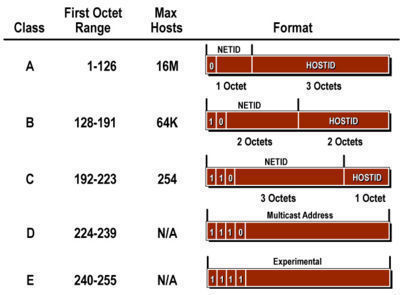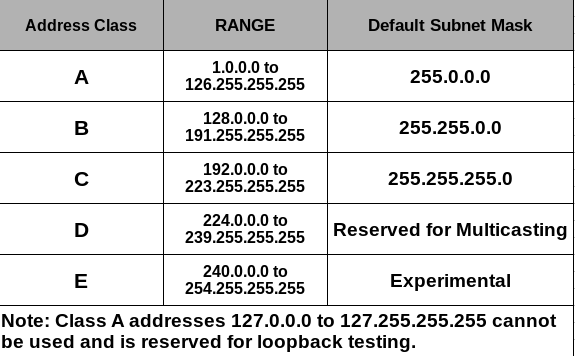Multicast IP addresses are used for one-to-many communication. The IP address belonging to Class A range from 1aaa to 126aaawhere a ranges from 0 to 255 Class B.
IPv4 is the original version of IP addresses which is still widely used today in all computer networks.

. There are private IP addresses public IP addresses static IP addresses and dynamic IP addresses. The default subnet mask for Class C is 255255255x. IP address with a first octet starts from 192-223.
Unicast IP addresses are used to direct packets to a specific host. Class B networks have a first bit value of 1 and a second bit value of 0 in the first octet. The other two classes are used for other purposes class D for multicast and class E for experimental.
What Are The Classes Of Ipv4 How To Identify Ip Class From A Given Ip Address Ip Address Classes Tech Faq Pin On. The IP protocol defines five different address classes. The IP addresses of this type are used for one-to-one communication.
10 Different Types of IP Addresses Used in Computer Networks 1 IPv4. These IP addresses can further be broken down into classes. While all IP addresses are made up of numbers or letters not all addresses are used for the same purpose.
The value of the first octet determines the class. Each type of IP address can be an IPv4 address or an IPv6 address. IP address classes.
Let us see all these types of IP address in detail. Class C is used for small to middle size networks. Class C networks have a first bit value of 1 second bit value of 1 and a third bit value of 0 in the first octet.
The IP addresses are divided into three different types based on their operational characteristics. The first three classes vary the portion of the address devoted to the network ID and the host ID. Each class has a range of valid IP addresses.
There are 4 types of IP Addresses- Public Private Fixed and Dynamic. These parts are of varying lengths depending on the class of the address. In classful addressing an IP address in class A B or C is divided into netid and hostid.
Class A B C D and E. Public Private Static Dynamic. The IP address belonging to Class B uses the first two octets to identify the network and the last two octets are used to identify the host.
1 Class A address 2 Class B address 3 Class C address 4 Class D address 5 Class E address Class A Address The first bit of the first octet is always set to zero. It has first second and third bit value as 1 and the fourth bit as 0. Class D addresses were designed for multicasting.
The first octet of Class C IP address has its first 3 bits set to 110 that is Class C IP addresses range from 19200x to 223255255x. So that the first octet ranges from 1 127. TCPIP defines five classes of IP addresses.
There are mainly four types of IP addresses. Based on the following rules IP addresses are categorized into five. In order to deal with the exhaustion of IPv4 addresses.
A B C D and E. IP addresses from the first three classes A B and C can be used for host addresses. The Host ID has 16 bits.
Class C addresses are most common. This is an address of a single interface which are used for one-to-one communication. The Network ID has 14 bits.
There are three different types of IP addresses within this classification. Class B IP addresses are used for medium and large-sized networks in enterprises and organizations. These classes are A B C D E and their possible ranges can be seen in Figure 2 below.
Public IP address A public IP address is an Internet Protocol address encrypted by various serversdevices. Classes of IP addresses. Class C IP address format is.
The classes of IPv4 addresses The different classes of the IPv4 address are the following. Different classes of IP Address and its range and subnet maskDownload Networking Plus App. Unicast IP addresses an address of a single interface.
Explain Different Classes of Ip Address and Their Addressing Scope Ge_Cassandra50 April 15 2022. Unicast IP addresses are used to direct packets to a specific host. In c1assful addressing a large part of the available addresses were wasted.
Class C gives 2097152 2 21 Network addresses and 254 2 8 -2 Host addresses. Class D is for multicast addresses which is something else entirely. A block in class C is probably too small for many organizations.
Types of IP addresses. Class E is experimental so you can just forget about those too. Among them public and private addresses are based on their location of the network private which should be used inside a network while the public IP is used outside of a network.
There are specific types of IP addresses. Among them public and private addresses are derived from their local network location which should be used within the network while public IP is used offline. 6 rows IP address classes.
They support up to 65000 hosts on 16000 individual networks.



0 Comments